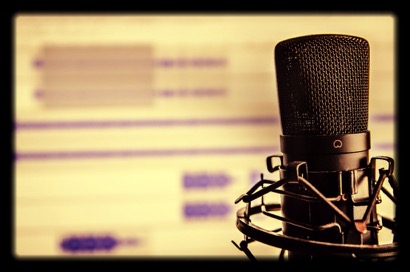

- © 2003 - 2024 Dynamix Productions, Inc. Contact Us 0



"In voice-over work, you have to actually do more work with your facial muscles and your mouth. You have to kind of exaggerate your pronunciation a little bit more, whereas with live action, you can get away with mumbling sometimes."
Mark Valley
What does it take to perform a voice-over? After talking with several industry veterans, it turns out that it's not as easy as they make it sound - and that's the whole point. In Part 1, we found out how these four voice-over artists got into the profession. This month, we learn the nitty gritty of preparation and technique.

John Campbell is a voice-over artist and semi-retired advertising and marketing writer and producer in Lexington. His voice has been hired by such clients as Klipsh, The NCAA, Valvoline, Fazoli's, and Brown-Forman. John is also a drummer in a classic rock band and enjoys noodling on the bagpipes. John describes his style as banks and hospitals to car dealers, and everything in between.

Kathie Stamps is a voice-over artist, writer, producer, sports broadcast engineer and is owner of Stamps Communications in Lexington. Her voice has been hired by such clients as Ocean Spray, Sports Illustrated, Grand Victoria Casino, and East Kentucky Power. Her background in music helped prepare her for a career in voice-overs. She describes her style as "smooth."

Tom Martin is a career journalist, reporting and anchoring on such news radio networks as ABC News, AP Radio, and RKO Radio Network, as well as being Paul Harvey's back-up host. Tom is also a lifelong pianist and keyboardist and currently plays with the Patrick McNeese Band. Tom says he inherited his deep smooth voice from his father.

Jim Jones is owner of Cherry Voiceworks in Dayton, Ohio. Jim specializes in commercials, narrations, politicals, broadcast promos, on-hold messages, and audiobooks. His voice has been hired for such clients as Arby’s, GE Jet Engines, Proctor & Gamble, Kroger, and Fasig-Tipton. Jim describes his style as "warm, buttered bread."

Preparation, from tongue warm ups to research, can be key to having success in a voice-over session. But sometimes life experiences unexpectedly work their way into the booth. Years ago, Jim worked a six-month stint in a shoebox factory. He probably wasn't thinking about how that experience would help his voice-over career at the time, but now it helps him while recording industrial narrations. "I learned about presses and machinery," Jim said. When a script might detail a mechanical process referencing movements, controls, and safety procedures, Jim can visualize the actions, "and it would help me with my interpretation."
In a perfect world, voice-over artists get a script beforehand so they can prepare. The reality is that copy is often being written and re-written right up until session time. But, as John points out, you'd better be able to correctly pronounce the name of the product. As he was preparing for a recording session for the spirit and wine giant Brown-Forman, he did some research on the scotch whiskey he would be selling. "Very few Americans,' John said, "even scotch aficionados, know how to pronounce Glenmorangie. So I made it part of my business to know how to pronounce the name of the product."
Physical preparation for a session is different for everybody. One actor I used to work with did push ups in the voice booth. Another sings scales. Others "purposefully hit the highest note they could possibly hit, then the mid-range, then the lowest note they could possibly hit," Tom chuckles. "If people only knew what what was going on in our cars as we were driving to the speaking gig, they probably would laugh." Jim chews bubblegum about 15 minutes before a session because "it loosens my jaws." Kathie brushes her teeth beforehand because she doesn't want to make excessive mouth sounds. John will do mouth exercises he learned in his Speaking for the Stage class.

Perhaps the hardest thing to learn and deftly apply to a voice-over is technique. Someone can have a lovely voice, but if no one can understand what's being said, it's a major fail. "My father always told me over-and-over," Tom remembers, "to always e-nun-ci-ate. And he would say it that way so that he got every syllable of the word in. That was his point, words have syllables for a reason."
I was a trombone major in college, and although I don't do voice-overs, I see many parallels between performing music and performing a voice-over. Two similarities are breathing and phrasing. Playing a wind instrument or singing correctly teaches you all about breath control. You learn to take in a quick, deep, and nearly silent breath. As you play or sing, controlling the flow of air from your diaphragm results in even tones and predictable air reserves. Phrasing is carefully planning your breaths around a group of notes while retaining musicality.
Reading a script is exactly the same way if done right. Kathie's music training allows her to see the parallels as well. "I think it's all very related," she says. "Music and voice-overs, singing and talking, writing and expressing. I just picked up that singing and talking were very related in the expression, the breath work, and putting the meaning across."
Sight reading, that is playing a piece of sheet music with little or no preparation, is another fundamental part of music training that can be applied to voice-over work. It helps Kathie to "give it the feel it deserves." When Tom was in live broadcasting, being handed cold copy was a common occurrence during a breaking event. "One of the tricks of the trade, especially in network news," he spells out, "you have to learn to read a couple of lines ahead of where you are. You're looking for punctuation marks and that sort of thing while you're reading along." Sometimes a script doesn't have natural places to breath or phrase, especially with long sentences. John notes that he looks for "places to breath, places to pause, and words you're going to emphasize."
And John adds, "What words you emphasize often makes the read." Much like playing music. You can have all the technique in the world, but if you can't get the meaning across, it another major fail. John scans a script with the questions, "What are the key words, what is the key thought, what are we trying to sell, and how are we trying to persuade an audience?" Kathie says she needs "the tiniest bit of 'who's your audience? Who am I?' I don't have that many styles, but if it's hyper-over-the-top salesy, or regular-medium-authoritative instructional, I just need a little bit of direction."
And that brings us to one of next month's topics: taking direction. Plus, our super-professionals offer advice to budding voice-over artists, and tips for writing narration scripts.